
“There’s nothing there, again,” I said, peering at the screen. I sighed. The wildlife camera had once again captured absolutely nothing. A few blades of grass, several dead leaves, a tree, and the blackness of night.
“It’ll be the rain, or a blade of grass or something setting it off again,” I complained, finger poised over the mouse button. But just before I clicked away from the disappointment of another failed camera shot, I spotted something. A tiny pinprick of light, just to the right of the large blade of grass. I blinked, and looked closer, ‘Yes, there, that looks like fur!’ I scanned carefully around the textured area in question, and as I peered even closer, I could make out what looked like a pair of ears. I gave a little yelp of delight, the screen wasn’t empty after all, there was a tiny little mouse!
The video footage that followed confirmed it. The little creature moved so incredibly fast, it was hard to tell for sure, but I believe it is a Wood Mouse. This is the UK’s commonest mouse and the one most likely to be found in our gardens. Wood mice are very similar to house mice in appearance but can be distinguished by their larger ears and eyes, comparative to their size.
Despite its name, the wood mouse will happily live anywhere they have a good food supply and safe cover. Also known as the long-tailed field mouse, they will build nests in wall cavities, sheds and garages, but favour making nests in the base of trees or shrubs. As my wildlife camera is situated at the base of a tree, I believe this may be where my mouse has made its underground home.
I have incredibly fond memories of my first close encounter with a wild mouse. Our old house was a semi-detached property in a suburban area with a large garden. My dog Leo developed a habit of barking at the same time each day, as I was upstairs working.
One day, he sounded so insistent, I decided to head downstairs and see what all the fuss was about. There, just outside the patio doors, sat a little mouse, nibbling on the bird seed that had fallen from our feeder. From then on, the mouse visited every day at the same time, sitting in the same spot, bold as brass, eating his fill. I became very fond of him, although Leo never quite got used to his presence.
At that time, I was really getting into gardening for wildlife and had created several log piles around the place. I had also installed a mini wildlife pond, had planted up lots of plants for pollinators and installed several bird feeding stations and a birdbath. Clearly my efforts were proving successful.
I loved that I had my very own resident mouse and was even happier when I spotted a second one scurrying along the back of my fence. However, I didn’t yet have the wisdom to consider what might happen next.
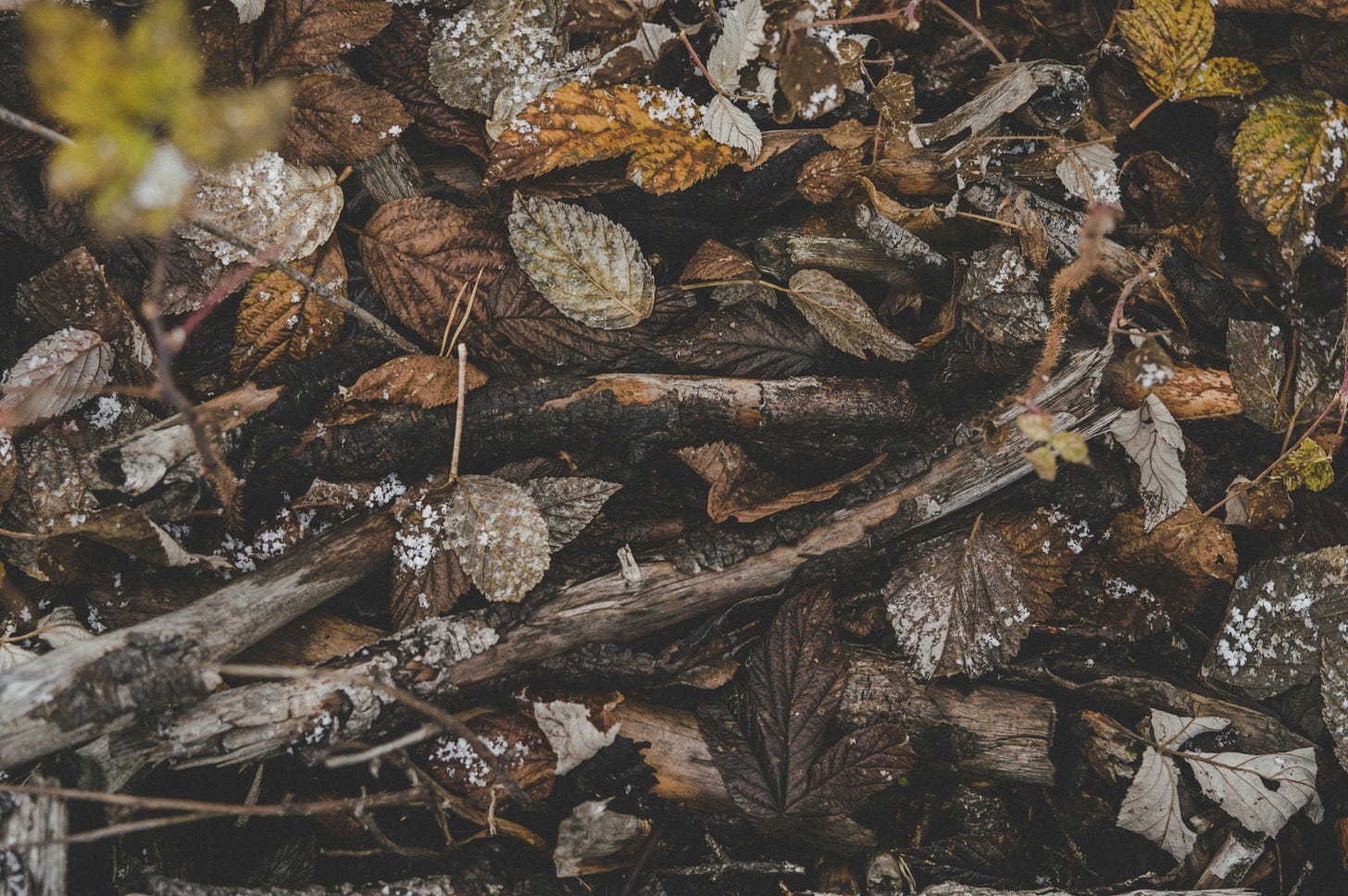
A few weeks later, trowel in hand, I was head down, digging a hole for my new buddleia bush, when I came face to face with not one but two adorable baby mice, peeking out from behind one of the log piles. As I continued to work, they ran along the fence beside me. I felt like Snow White, with birds flitting amongst the trees, bees buzzing amongst the flowers, and mice scurrying through the undergrowth as I tilled the earth. Now all that was needed was for me to burst into song.
Until I spotted yet another baby mouse, and then another. As I stood up and looked around me in surprise, I realised I was surrounded. Now as you will know, I am always happy to encourage wildlife into my space. But, when it comes to rodents, I do try to be careful. When the number of mice began to outnumber the number of humans, I felt perhaps it was time to stop encouraging them quite so much, especially when they were so close to our house. So, a little reluctantly, I dismantled the log piles and moved the bird feeders a little further from the house.
Now, however, I’m happy to say that with an acre of land to fill, they can breed as much as they wish. And I’m sure they will, as female wood mice can have up to six litters a year, of between four and eight young. These baby mice are called pups or pinkies, due to their lack of fur at birth.
Wood mice will eat seeds, fruit and nuts when available, and if not, they will also eat invertebrates such as earthworms, caterpillars and centipedes. I put down seed on a regular basis for ground feeding birds and pheasants, so it’s perhaps not surprising that the mouse has discovered this and is taking full advantage.
Mice are an important food source for larger mammals such as foxes, badgers, stoats and weasels, also birds of prey. In fact, according to The Wildlife Trust, Tawny Owls may not breed if wood mouse numbers are low.
Despite being considered pests by many, due to the crop damage they can cause on agricultural land, by digging up and eating seeds; mice do play a key role in the natural environment. From distributing plant seeds to being prey for the larger animals, whose populations fall if the mice population is low.
According to Better Planet Education:-
‘Their sense of smell is so acute; they can sniff out the exact position of each seed in a row of newly-planted peas or beans. They dig directly down to the seeds rather than dig around at random.’
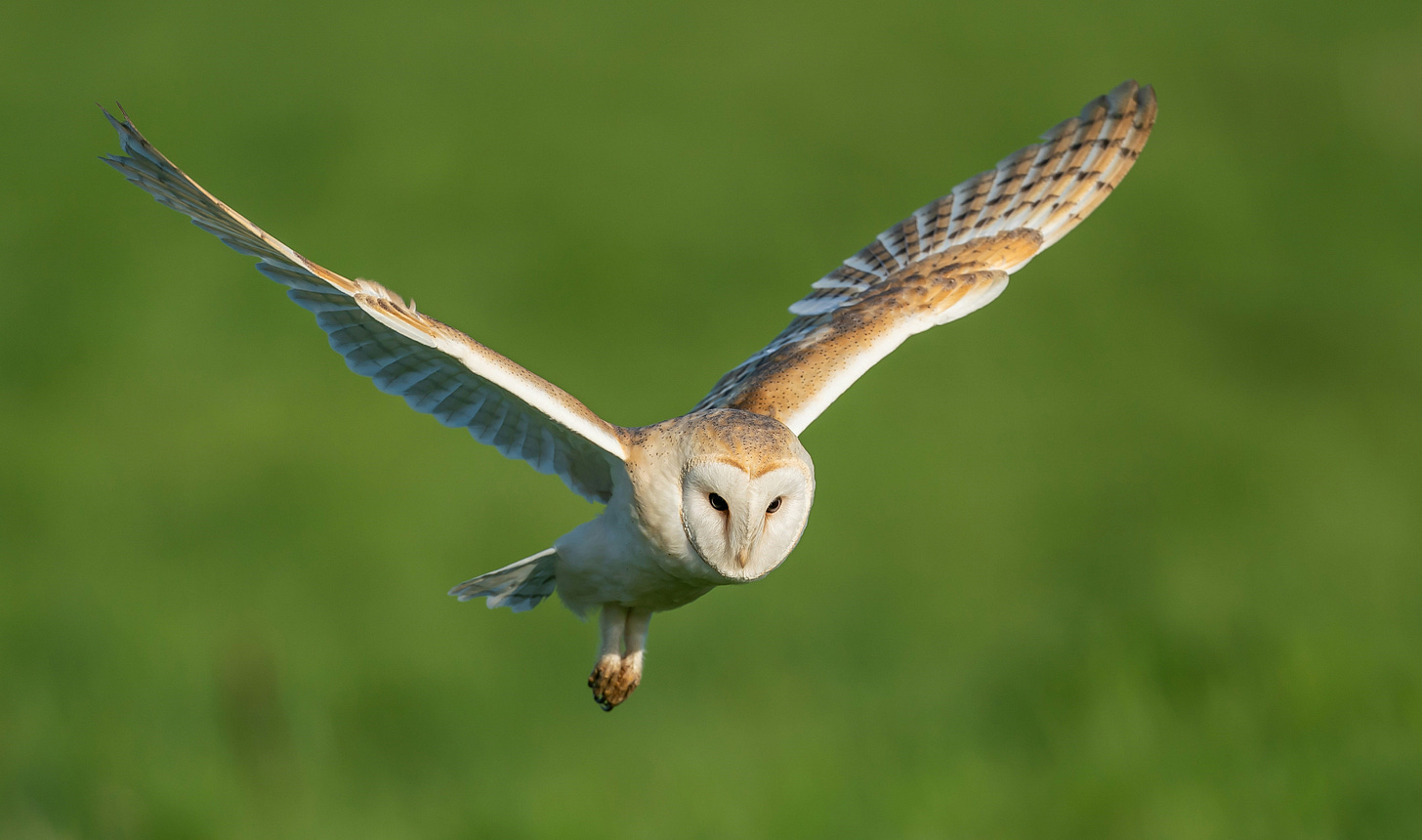
As I’m not a farmer, I’m happy to welcome these sweet secretive little creatures into my space, and I hope that there are more of them. And even though I do not like to think of them being predated, I do love hearing my tawny owls, so anything that will encourage them to stick around is a bonus.
You may recall from my post The Fox, that the first time I spotted my little mouse, the fox was not too far behind. And so, it continues, as when I review my wildlife camera footage on a weekly basis, the shots flit back and forth as I work my way through the night, from mouse to fox and back again. I just hope that my little mouse is as wily as Jerry (from the child’s cartoon ‘Tom and Jerry’) and can continue to outwit my foxes.
I have high hopes that she can, as did you know that wood mice can shed the skin on their tail in a bid to escape predators? They can also jump up to 30 times their own body height, thanks to their large hind feet, and they are agile climbers.
I got to witness this awesome jumping ability on my wildlife camera. Here is a lovely little video of the wood mouse activity in my garden if you would like to see it for yourself. My husband has nicknamed her ‘super mouse’
I’m feeding my resident foxes up very well with dog food, apples and nuts, so hopefully this will keep them distracted as the mouse returns night after night, to a little pile of bird seed that I leave out especially for her.
Wood mice are mostly nocturnal, emerging from their burrows at night to forage for food. They tend to prefer dark, moonless nights, for safety, and use their large eyes and ears to find their way around, often venturing into more open areas than other small rodents. They gather food stores in underground burrows and sometimes in old birds’ nests.
I was pretty sure that this mouse would not be the only one around. Although I was sad to learn that they rarely live for longer than a year.
I’ve had evidence of mouse activity in my greenhouse, where packets of sweetcorn kernels and broad beans have been nibbled through and thoroughly emptied. One cheeky little fella broke into our brick-built outhouse, via a small hole that had been created when we had an air source heating system installed and proceeded to nibble away at the insulation around the water cylinder. This was presumably to make itself a cosy bed somewhere, until my husband filled in the hole and scuppered its plans.
Then I noticed that someone had set up house in our brash pile at the bottom of the garden. As I talked about in my post ‘February Favourites’ I set up a wildlife camera to catch the culprit, fully expecting to discover a rat or a hedgehog.
I put down some fruit and seed at the front of the hole. After several lovely shots of a greedy blackbird, who was looking likely to leave nothing for any nocturnal creatures. I finally spotted some action. It was a wood mouse again, and not one this time, but two, feasting on my offering. They scurried back and forth, using two different entrances in the pile of sticks, branches and leaves. From then on, the brash pile was affectionately nick-named ‘mouse mansion.’
This behaviour to fit perfectly with Better Planet Education’s description of how a mouse makes its home:-
A mouse digs its own system of burrows where it makes an area for storing food and a nesting chamber for the young. Several adults may live together in the same network of tunnels which have two open entrances. Others are blocked with leaves, twigs, soil and stones.
Wood mice don’t hibernate, but they can go into a torpid state -almost like hibernation -to survive food shortages during particularly cold winters. I’m pretty sure that they will be nice and cosy deep inside the brash pile
Today I spotted a small hole in the ground, a short distance from the brash pile, and next to an old tree stump where I leave daily offerings for the squirrels. I wonder if this is another secret entrance to mouse mansion, enabling them to have a safe passage to another source of food. Or, if a different creature has set up home there. I plan to set up a wildlife camera to see if I can find out – watch this space.
The rodents in our space often surprise me, I feel as though I’m being tricked, just like they do in the cartoons. It seems that every time I think that rats have moved in, I get surprised by the feisty wood mouse.
Then, when I see someone has made themselves a cosy home in a bag of straw in our greenhouse, I assume it will be a sweet little wood mouse, but I’m disappointed to discover that it’s a rat. Not exactly who I would hope for in a space where I plan to grow food.
The latest surprise was at our bird feeding station. I have seen rats in this area before and had to stop feeding the birds for a while to deter them. Recently I spotted that underneath the paving flags, a couple of holes had been dug. They are not small holes, so I suspected rats. I had seen a little mouse running in and out of a hole underneath a rock, to steal some seed, and was relieved. I was once told that rats and mice will not inhabit the same space, so that meant I could relax in being rat free. But when I saw the size of the hole, and then a day later, saw this…
I didn’t think a tiny little mouse would be capable of dragging a fat ball across the garden to its underground space. This had to be a rat. Still, I set up my wildlife camera and put a fat ball out to confirm my suspicions, just in case I needed to adjust my bird feeding habits. I know that we have rats around, it’s a natural part of living close to farmland. But I do not want to encourage them close to my house.
However, to my utmost surprise, my camera didn’t capture any rats at all, just this little fella, having a late supper!!
I decided to take a little look into the spiritual meaning of the mouse.
According to ‘What is My Spirit Animal’ in folklore the mouse has an important role to play, being held as a sacred creature to the Greek deity, Apollo. I particularly like how they are described as ‘a powerhouse tucked into a tiny package’
Here is a little more about the spiritual symbolism of this adorable creature:-
Mice are burrowing creatures. They love digging in the dirt, giving them a secure connection to the Earth Element. Some lore tells of Mice digging toward The Underworld or other realms. European superstitions claim Mice carried human souls toward their next reality.
As an Animal Spirit Guide, Mouse is a reminder that people must take care of themselves and the environment to elude sickness and disease. Mice are obsessive about remaining clean and engage in non-stop grooming. No matter what, Mice are messengers of tidiness and of having your figurative cheese in order.
If you love environmental-friendly living, Mice are outstanding role models. They know how to hoard and conserve in ingenious ways. The Mouse Animal Spirit remains ever aware that abundance wanes, and so the creature prepares for the lean periods in advance. As a Spirit Animal Guide, Mouse comes to symbolize the careful use of resources, whether it’s regarding finances, personal energy, or emotional output. Mouse’s presence means it’s time to monitor what you’re consuming.
As someone who is still struggling to kick the bad habits that crept in over the festive period. I’m happy to accept the wisdom of the Wood Mouse.
As the weather warms up, the mice are becoming less secretive, perhaps getting used to our habits, as we have seen them several times during the day. When standing close to the brash pile, my husband had one run right past his foot. I spotted one hiding under the holly a few days ago, watching me from a safe distance with its huge black eyes, waiting for me to leave so it could return to foraging underneath the bird feeder.
So, it seems that I can relax in the knowledge that wood mice are thriving on my plot, and hopefully the larger predators will be thriving too. But I hope that my favourite little mouse, the one who evades the fox on a nightly basis, and my first wildlife camera capture, gets to live out his short life in peace and comfort in mouse mansion.
How do you feel about mice? Do you have them in your garden?




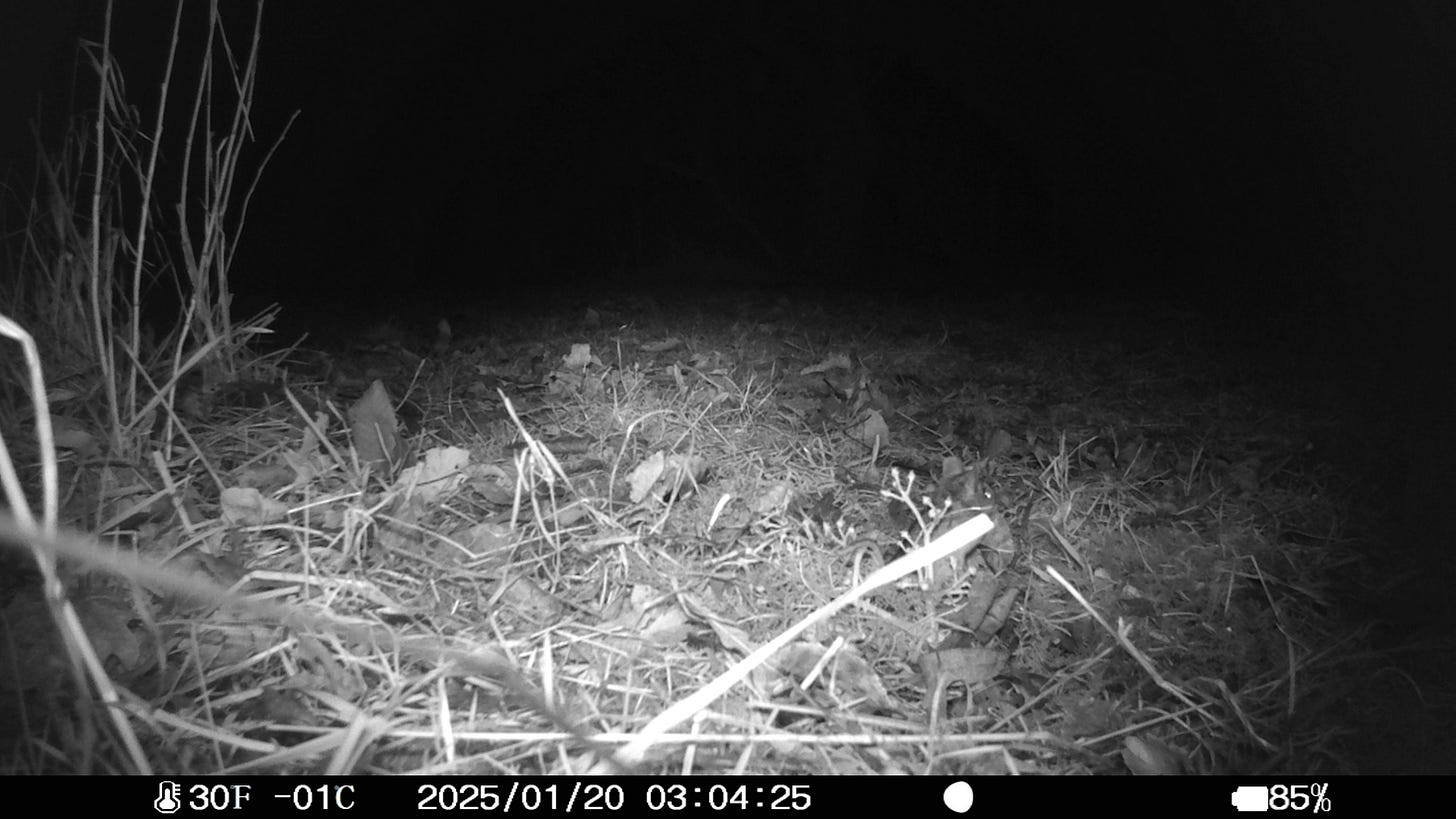
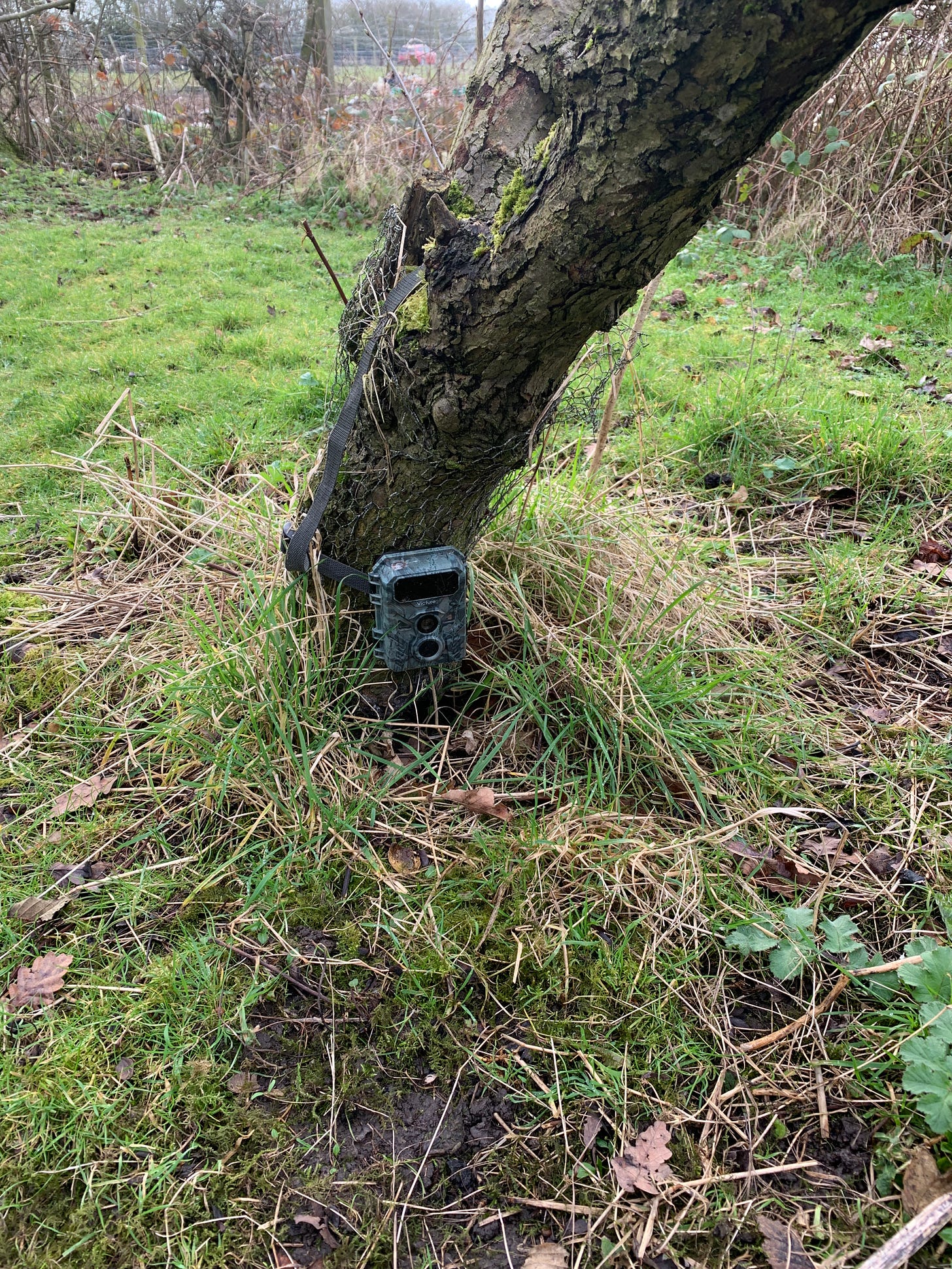
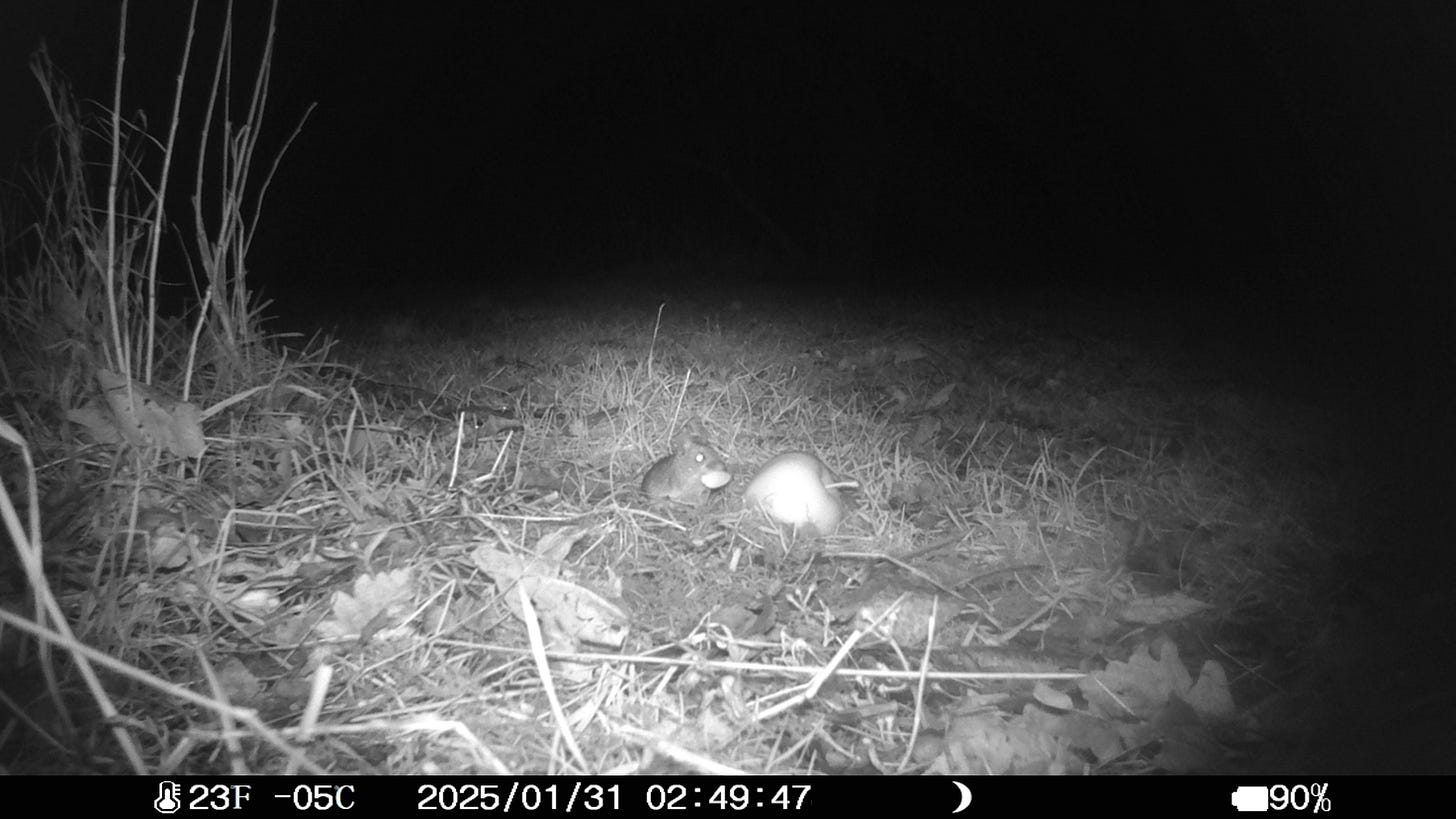
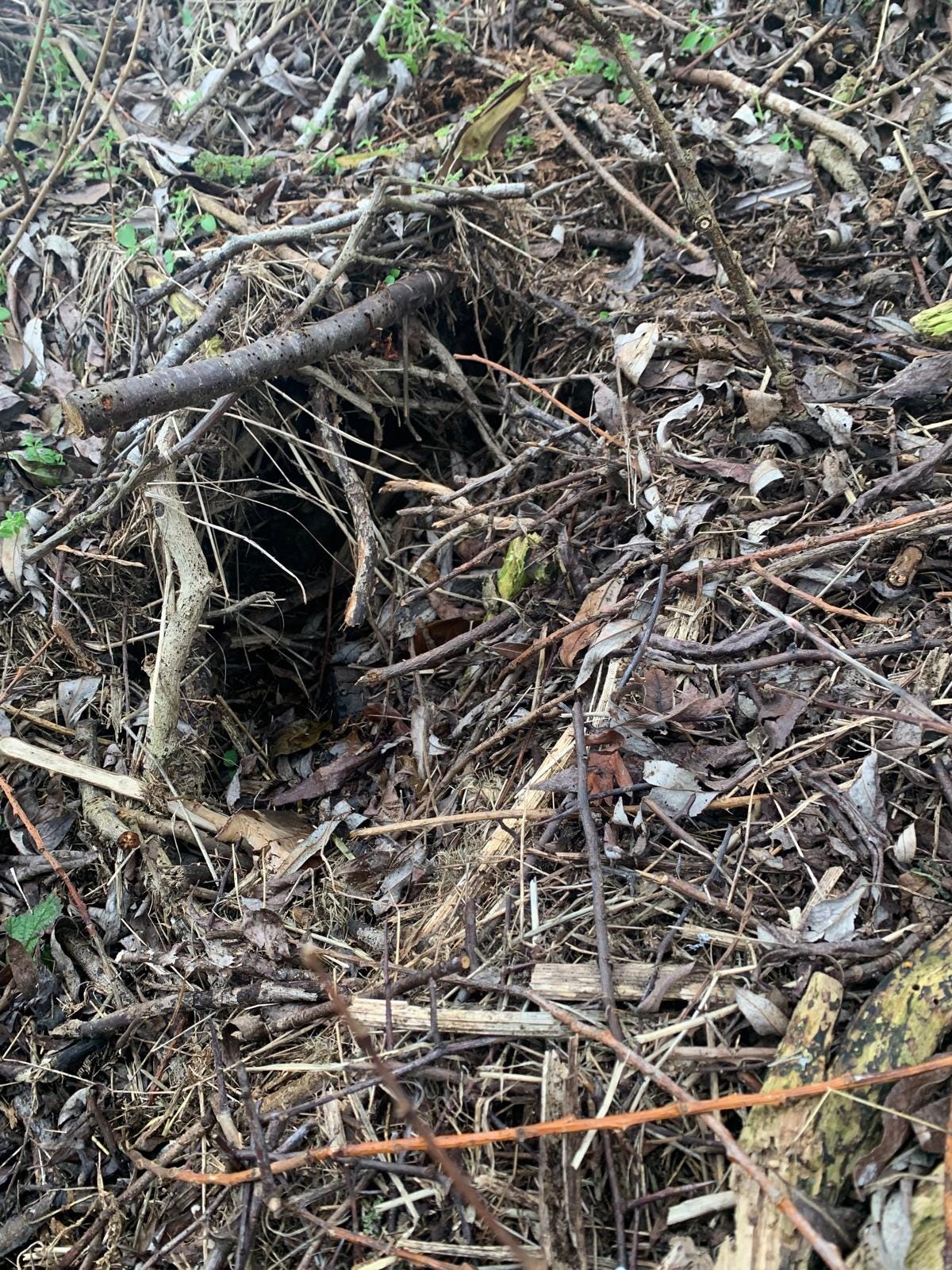
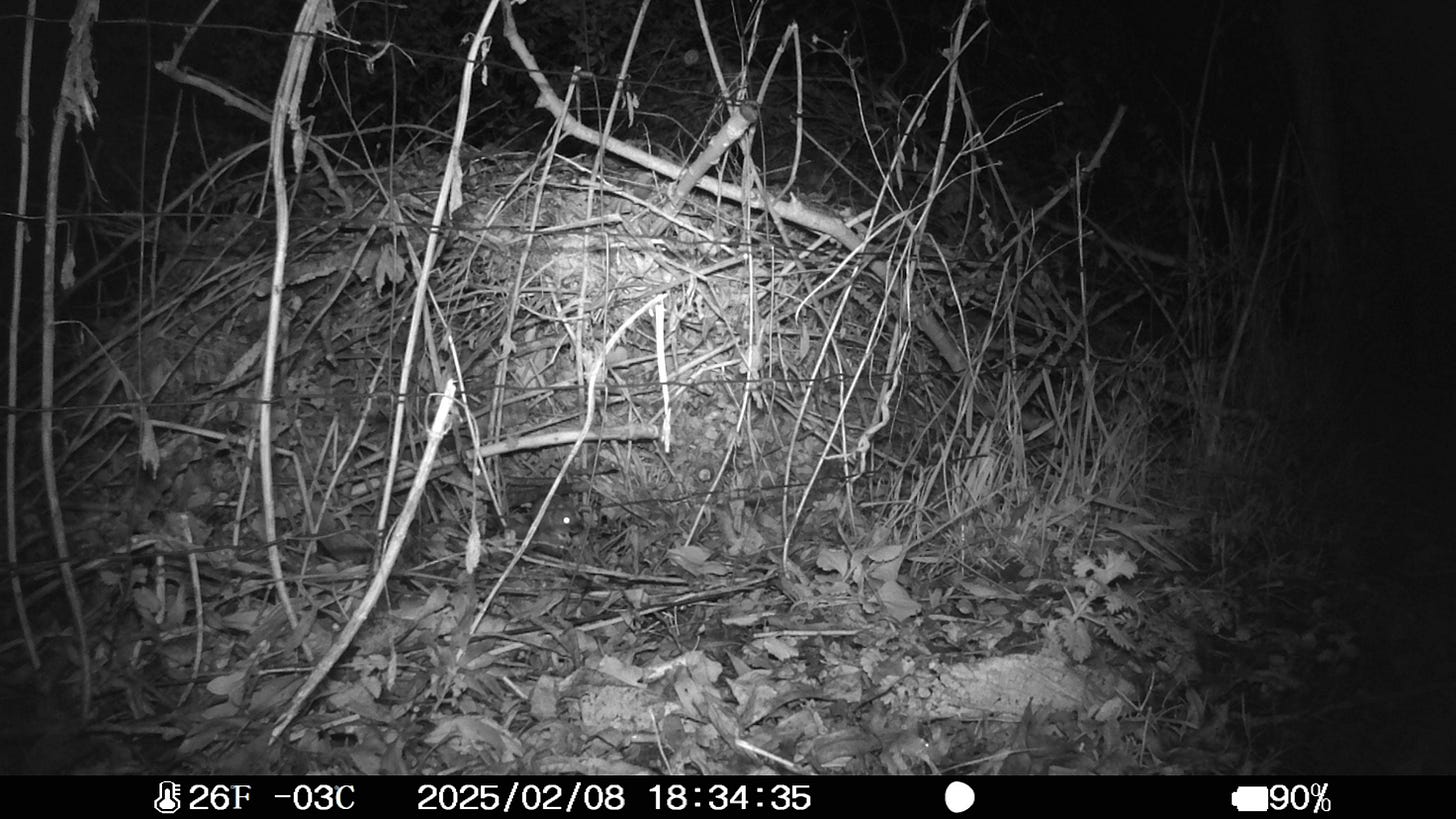
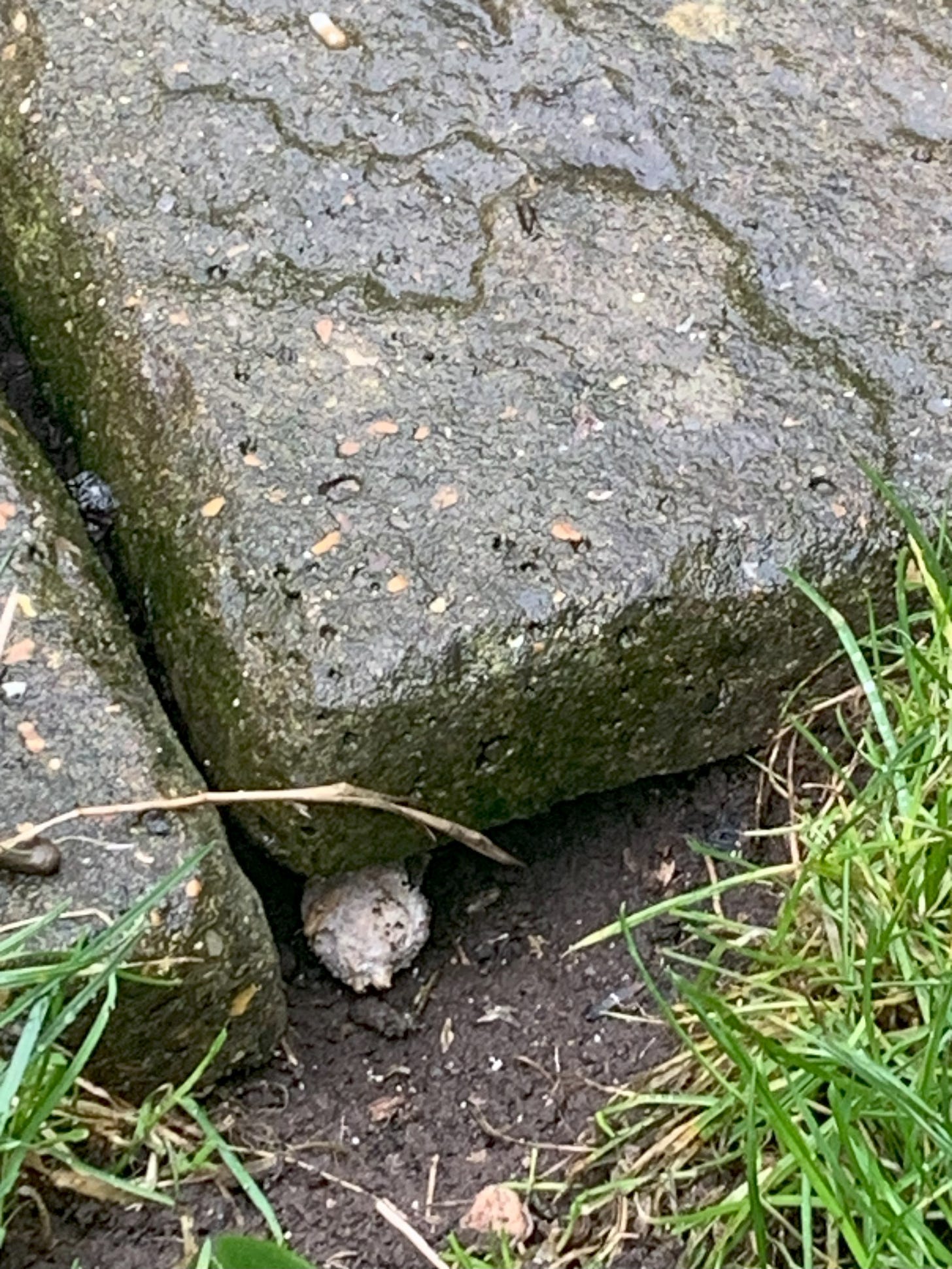


I really enjoyed that video and you've captured well their speed and jumping ability! I haven't seen many mice on my hikes in Nature. Mostly the odd quick movement and rustling of dry leaves on the ground when I'm sitting still watching a bird up in the trees. I do like to see them and appreciate their role in the larger part of a healthy ecosystem. Thanks for sharing.
Such a lovely post and video. We played host to a family of shrews a few years ago, beautiful little creatures. The Tawny Owl 🦉 often sits in the Birch in the garden so we hopefully have mice too.